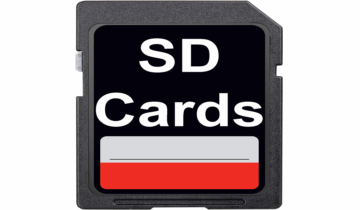 Home
DFS
SB
OD
SDN
Home
DFS
SB
OD
SDN
Some of them have some symbols such as a circled number, a number that's inside a bigger "U", or some that have a V rating.
Some are HC, XC I or XC II.
So how do you know which ones you need to get?
Basically speaking, if you have anything of a basic use such as sharing or storing files and pictures, and you're using them in a cellphone or computer, then the least you would need would be an SD HC class 10 SD card.
If you need to record video, then depending on how fast you want to capture the motion, then you need to look for an SD card with a V60 or V90 rating.
So how do these different standards stack up?
Let's start with the three speed classes.
There's the Speed Classes which are classes 2, 4, 6 and 10. The Speed Classes are on the SD HC line of SD cards. Class 10 is part of the High Speed Bus IF product family. For most purposes outside of recording video, you don't want anything less than a class 10 for fast copying of files, but not the fastest.
There's the UHS Speed Classes which are classes 1 and 3, are on the SD XC 1 line of SD cards, and both are part of the UHS Bus IF product family for UHS-1, UHS-2 and UHS-3.
And finally, there's the Video Speed Classes which are classes V6, V10, V30, V60 and V90, are on the SD XC II line of SD cards, and depending on speed, the V6 and V10 are part of the High Speed and UHS Bus IF product families, the V30 is part of the UHS Bus IF product family, and the V60 and V90 are part of the UHS-2 and UHS-3 product families.
So what's the difference between the cards of different classes and how can they overlap?
Here's how they stack up.
First off, there's the 2MB/sec minumum sequential write speed. It comes in the SD HC class 2 standard, the slowest speed. This may be obsolete and no longer in production. Not suitable for recording video until you reach the 10MB/sec class, which we will discuss in a minite.
There's the 4MB/sec minimum sequential write speed. It comes in the SD HC class 4 standard. This may be obsolete and no longer in production.
There's the 6MB/sec minimum sequential write speed. It comes in the SD HC class 4 standard, as well as the SD XC 2 V6 standard. I don't reccommend this standard for recording video.
Now, we reach the 10mb/sec minimum sequential write speed. It comes in the SD HC class 10 standard, the SD XC 1 U1 standard, and the SD XC 2 V10 standard. This is the minimum you should buy as of 2019. I buy the SD XC 1 U1 standard for better results than the SD HC class 10 standard. It's suitable for recording standard video, but for HD video, please see the next paragraph.
We're now up to the 30mb/sec minimum sequential write speed. We're out of SD HD classes, but if it existed, it would be class 30, but why get this card with a slower bus speed throughput when you can use the SD XC 1 U3 standard at the least, or upgrade to the SD XC 2 V30 standard for recording HD video.
Now we reach the video standard speeds of 60mb/sec and 90mb/sec minimum sequential write speeds. They come in the SD XC 2 class only, with the 60mb/sec as V60 for recording 4K video, and 90mb/sec and V90 for recording 8K video.
You need to be sure that the class and speed of the SD cards you use will work with the smartphone, digital camera or computer. If your host device needs a 4MB/sec minimal write speed requirement, you can use everything I mentioned escept for the 2mb/sec write speed SD card, which is the SD HD class 2 standard. For devices that need a UHS Speed Class 1 SD card, you must avoid the SD HD class and go with the SD XC 1 class line of cards, or step up to the SD XC 2 class line of cards except for the V6 speed.
An older obsolete family is the SD (SDSC), which had a capacity range of 128 MB to 2 GB.
The SDHC family of cards has a capacity range of 2 GB to 32 GB.
The SDXC family of cards has a capacity range of 32 GB to 2 TB.
There's the new SDUC family, wich has a capacity range fo 2 TB to 128 TB.
© 1995-2023. davesfunstuff.com. All Rights Reserved. Reproduction of any part of this website without expressed written consent is prohibited.



![]()